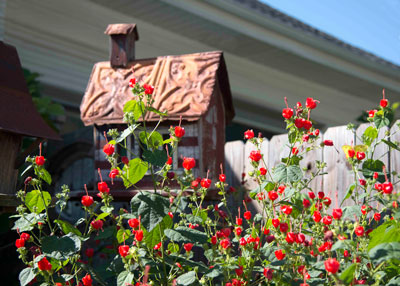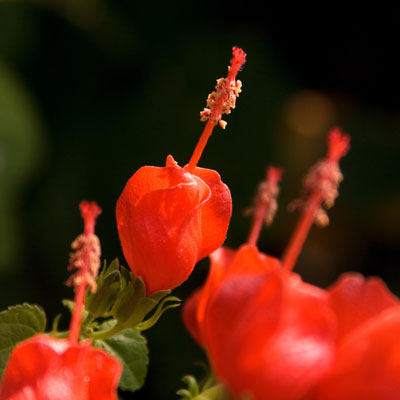Plant of the Week: October 19, 2017

Photo: Turk’s cap in this eclectic old McKinney garden is in full bloom currently.
Turk’s Cap Triumphs in Fall
Our featured plant this week has actually been putting on quite a show across Texas the past several weeks. We know it as Turk’s cap. Botanically it’s Malvaviscus drummondii, and it’s native across a broad band of Central and South Texas east across the South, also in Cuba and Mexico. It’s usually found along stream banks and at the edges of woodlands. It grows equally well in calcareous limestone soils and sandy lands, too.

Photo: You can see Turk’s cap’s relation to hibiscus by a quick glance of its blooms.
By looking at its flowers you can see that this plant is out of the hibiscus clan, but its flowers are spiraled, like rolled sheets of red paper. They never really open, but that doesn’t slow down the hummingbirds. They’re attracted to Turks cap like teenagers are drawn to their phones. And, another significant difference: Turks cap grows and blooms well in partial to fairly heavy shade.
Turks cap dies to the ground with the first hard freeze in the fall, but the clumps reemerge each spring, getting bigger and fuller with each passing year. By summer, the blooming has started, and it will continue right up to frost. The plants grow to 4 to 5 feet tall and wide, although a more compact form is also sold. You’ll occasionally see pink- and white-flowering forms in nurseries. A variegated type offers not only flowers, but also interest through foliage.

Photo: Pink Turk’s cap is uncommon but attractive. Red species form is in the background.
How you grow it…
Plant Turk’s cap in the back of the perennial garden, probably toward an end that extends back beneath shade trees. Allow it ample room to grow and fill in. They do best in well-prepared garden soil to which you’ve added generous amounts of organic matter and rototilled to a depth of 12 or 14 inches.
Turk’s cap can be dug and divided in fall, but honestly, it’s easier just to buy vigorous transplants in spring. The plant has become mainstream, so you’ll have no trouble finding the species. The unusual types may present more of a challenge, so when you run across them while you’re out shopping don’t pass over them or you may end up regretting it.
